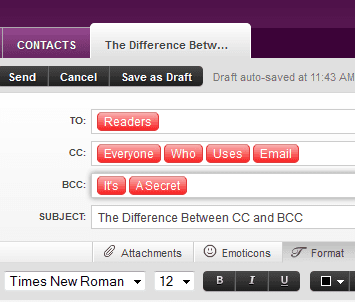I found a great resource through the Indeed website, which is a site that is used to find work opportunities. First, writing a professional email is important for various reasons but mainly to keep up a good reputation of the business, communicate with clarity, and to save time. The first step in writing an email is actually having an appropriate email address. It should be easy for the people you are emailing to know who is communicating to them. Next is the Subject line. It should be short and specific and state the topic or goal of the entire email. Then is the salutation. It should correlate with the tone of the email, so in this situation it should be professional and not too personal. The body of the email is similar to writing a paper. The length of the email does not matter, only if you ensure you are being concise with the writing, and you are getting all of the important information. Near the end of the writing - again, similar to writing a paper - there should be a place to close the body of the email. After that, is the sign off and signature. The sign off for example is "Regards, Best, Sincerely," Etc. My go to is usually "Very respectfully,". Also to add, it is imperative that you know who will be seeing the email.

This image shows a good way to remember what the different labels mean. In the "To:" section, is where you would put the email address of the person that the email was meant for, or who you are specifically writing to. The "CC:" section is where you would insert the email of a person that would need to know that the email is being sent, but the email doesn't specifically apply to, but the recipient of the email can see that another person is able to see the email. Lastly, the "BCC:" section is for people that will view the email but that is hidden from the receiver of the email. Use this youtube video about great tips on
Writing Professional Emails.
So, let's pretend you are the manager of a mid-sized department. You have been noticing that emails from your staff has been lacking professionalism, positivity, and efficiency. I will write an email to my staff explaining professional email standards that will be utilized moving forward.
To: sally.seashell2@gmail.com + rest of my department@gmail.com
CC: Big_Boss1@gmail.com
BCC:
Subject: Improving email etiquette and communication standards.
Hello team,
I hope this finds you well. Over the past weeks, I have noticed a pattern that I needed to address on our communication, specifically through email. It is important that when writing an email that you maintain a professional outline, despite how often we may write to each other. Also, prioritize time sensitivity and clarity in your writing.
I will be implementing a new standard emailing procedures to improve tone and efficiency on your communication.
Please review the beneficial practices below that we will now be following as a team:
Utilizing "BCC" and "CC" (properly)
- CC: Including people that should be aware of the emails being exchanged, but does not require them to participate in the conversation. This will be visible to the receiver to who was CC'd.
- BCC: Including people that you wish to be aware of the emails, but will be hidden from the receiver of the email.
Professionalism and Tone
- Use appropriate greetings and closings.
- Use respectful tone.
- Avoid casual language like "Hey, Hows it going, or FYI" etc.
Clarity and Efficiency
- A lengthy email does not always equal a good email. Be concise but specific.
- Utilize bullet points.
- Avoid big bodies of writing. That usually is not thoroughly read through.
By using these new standards, we can ensure a positive outlook on our productivity and clarity in our communication. Please let me know if any of you have questions.
Very respectfully,
Valeria Estrada-Contreras
(signature)".


Comments
Post a Comment